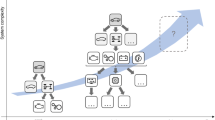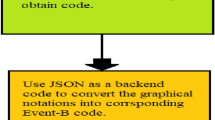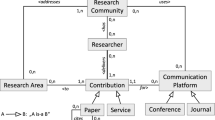Abstract
Failure diagnosis is one of the key challenges of Service oriented Architectures. One of the methods of identifying occurrences of failure is to use Diagnosers; software modules or services are deployed with the system to monitor the interaction between services for identifying whether a failure has happened or may have happened. This paper aims to present a suitable modelling framework to allow automated creation of Diagnosers based on Discrete Event System (DES) theory. Coming up with an appropriate modelling language framework is a prerequisite to applying DES techniques. Modelling languages popular in DES, such as Petri nets and automata, despite being sufficiently adequate for modelling, are not well adopted by the SoA community. Inspired by Petri nets and Workflow Graph, the modelling suggested in this paper closely follows BPEL that is widely used by the community. In particular, our language includes constructs that are supported by major tool vendors. To demonstrate that the suggested formal language is a suitable basis for the application of DES theory, we have extended one of the existing DES methods for the creation of centralised Diagnoser. Two algorithms for creating Diagnosers are put forward. These algorithms are applied into the models that are abstracted from the BPEL representation of the involving services. As a proof of concept, an implementation of the suggested approach is created as an Oracle JDeveloper plugin that automatically produces new Diagnosing services and integrates them to work with existing services. The paper ends with a series of empirical results on the performance-related aspects of the proposed method.
Similar content being viewed by others
References
Aghasaryan A, Fabre E, Benveniste A, Boubour R, Jard C (1998) Fault detection and diagnosis in distributed systems: an approach by partially stochastic Petri nets. Discret Event Dyn Syst 8(2): 203–231
Aho AV, Sethi R, Ullman JD (1986) Compilers: principles, techniques, and tools. Addison-Wesley, USA
Allweyer T (2010) BPMN 2.0.BoD
Alodib M, Bordbar B (2008) A model driven architecture approach to fault tolerance in Service oriented Architectures, a performance study. In: Proceedings of the 12th enterprise distributed object computing conference workshops, pp 293–300
Alodib M, Bordbar B (2009) A model-based approach to fault diagnosis in Service oriented Architectures. In: Proceedings of the IEEE European conference on web services (ECOWS), The Netherlands, pp 129–138
Alodib M, Bordbar B, Majeed B (2008) A model driven approach to the design and implementing of fault tolerant Service oriented Architectures. In: IEEE conference on digital information management, pp 464–469
Ammarguellat Z (1992) A control-flow normalization algorithm and its complexity. IEEE Trans Softw Eng 18(3): 237–251
Andrieux A, Czajkowski K, Dan A, Keahey K, Ludwig H, Nakata T, Pruyne J, Rofrano J, Tuecke S, Xu M Web services agreement specification (WS-Agreement)
Arkin A, Askary S, Fordin S, Jekeli W, Kawaguchi K, Orchard D, Pogliani S, Riemer K, Struble S, Nagy PT, Trickovic I, Zimek S (2002) Web service choreography interface (wsci) 1.0. Technical report
Arsanjani A (2005) Empowering the business analyst for on demand computing. IBM Syst J 44(1): 67–80
Baresi L, Guinea S, Nano O, Spanoudakis G (2010) Comprehensive monitoring of bpel processes. IEEE Internet Comput 14(3): 50–57
Baresi L, Guinea S, Plebani M (2007) Business process monitoring for dependability, pp 337–361
BEA, IBM Microsoft, SAP A, Systems S (2003) Business Process Execution Language for web services. version 1.1
Cabasino M, Giua A, Lafortune S, Seatzu, C (2009) Diagnosability analysis of unbounded Petri nets. In: Proceedings of the 48th IEEE conference on decision and control (CDC09), Shanghai
Casati F, Ceri S, Pernici B, Pozzi G (1995) Conceptual modeling of workflows. Springer, Berlin, pp 341–354
Cassandras C, Lafortune S (2007) Introduction to Discrete Event Systems. Springer, Berlin
Chinnici R, Moreau JJ, Ryman A, Weerawarana S (2006) Web services description language (wsdl) version 2.0
Dahl OJ, Dijkstra EW, Hoare CAR (1972) Structured programming, 3 edn. Academic Press, London
Debouk R, Lafortune S, Teneketzis D (2000) A coordinated decentralized protocols for failure diagnosis of Discrete Event Systems. Discret Event Dyn Syst Theory Appl 10(1): 33–86
Department: Software Verification, U.o.M. Stress test strategy
Dijkstra E (1979) Go to statement considered harmful, pp 27–33
Fasbinder M (2007) Using loops in websphere business modeler v6 to improve simulations and xport to bpel. Technical report, WebSphere Software Technical Sales, IBM
Friess M, Fussi E, Konig D, Pfau G, Ruttinger S, Schwenkreis F, Zentner C (2006) Websphere process server v6—business process choreographer: concepts and architecture. IBM Group
Genc S, Lafortune S (2003) Distributed diagnosis of discrete-event systems using Petri nets. In: International conference on applications and theory of Petri nets, pp 316–336
Giua A, Seatzu C (2002) Observability of place/transition nets. IEEE Trans Autom Control 47(9): 1424–1437
Giua A, Seatzu C (2005) Fault detection for Discrete Event Systems using Petri nets with unobservable transitions. In: 44th IEEE conference on decision and control, pp 6323–6328
Hamscher W, Console L, de Kleer J (eds)(1992) Readings in model-based diagnosis. Morgan Kaufmann Publishers Inc., USA
Jiang S, Kumar R (2004) Failure diagnosis of discrete-event systems with linear-time temporal logic specifications. IEEE Trans Autom Control 49(6): 934–945
Jiroveanu G, Boel RK, Bordbar B (2008) On-line monitoring of large Petri net models under partial observation. Discret Event Dyn Syst 18(3): 323–354
Juric MB, Mathew B, Sarang P (2004) Business Process Execution Language for web services. Packt Publishing, Birmingham
Koehler J, Hauser R (2004) Untangling unstructured cyclic flows—a solution based on continuations, pp 121–138
Koehler J, Vanhatalo J (2007) Process anti-patterns: how to avoid the common traps of business process modeling, part 1. Technical report, IBM WebSphere Developer Technical Journal
Le Guillou X, Cordier MO, Robin S, RozÉ L (2008) Chronicles For on-line diagnosis of distributed systems. Research report
Le Guillou X, Cordier MO, Robin S, Rozé L (2008) Chronicles for on-line diagnosis of distributed systems. In: Proceeding of ECAI, The Netherlands, pp 194–198
Li Y, Ye L, Dague P, Melliti T (2009) A decentralized model-based diagnosis for bpel services. In: Proceedings of the international conference on tools with artificial intelligence, USA, pp 609–616
Murata T (1989) Petri nets: properties, analysis and applications. Proc IEEE 77(4): 541–580
Reisig W (1985) Petri nets: an introduction. Springer, New York
Ricker L, Lafortune S, Genc S (2006) Desuma: a tool integrating giddes and umdes. In: WODES
Sadiq W, Orlowska ME (1999) Applying graph reduction techniques for identifying structural conflicts in process models. In: Proceedings of CAiSE, pp 195–209
Sampath M, Sengupta R, Lafortune S (1995) Diagnosability of discrete-event systems. IEEE Trans Autom Control 40: 1555–1575
Vanhatalo J, Völzer H, Leymann F (2007) Faster and more focused control-flow analysis for business process models through sese decomposition. In: Proceedings of the international conference on service-oriented computing, pp 43–55
van der Aalst WMP (1998) The application of Petri nets to workflow management. J Circuits Syst Comput 8(1): 21–66
van der Aalst WMP, Hirnschall A, Verbeek HMWE (2002) An alternative way to analyze Workflow Graphs. In: Proceedings of the international conference on advanced information systems engineering, London, pp 535–552
Wang Y, Kelly T, Lafortune S (2007) Discrete control for safe execution of it automation workflows. In: EuroSys, pp 305–314
Wang Y, Yoo TS, Lafortune S (2007) Diagnosis of Discrete Event Systems using decentralized architectures. Discret Event Dyn Syst 17(2): 233–263
Yan Y, Dague P (2007) Modeling and diagnosing orchestrated web service processes. In: IEEE conference on web services, pp 51–59
Yan Y, Pencole Y, Cordier MO, Grastien A (2005) Monitoring web service networks in a model-based approach. In: ECOWS05
Author information
Authors and Affiliations
Corresponding author
Rights and permissions
About this article
Cite this article
Alodib, M., Bordbar, B. A modelling approach to Service oriented Architecture for on-line diagnosis. SOCA 6, 303–319 (2012). https://doi.org/10.1007/s11761-012-0118-y
Received:
Revised:
Accepted:
Published:
Issue Date:
DOI: https://doi.org/10.1007/s11761-012-0118-y




